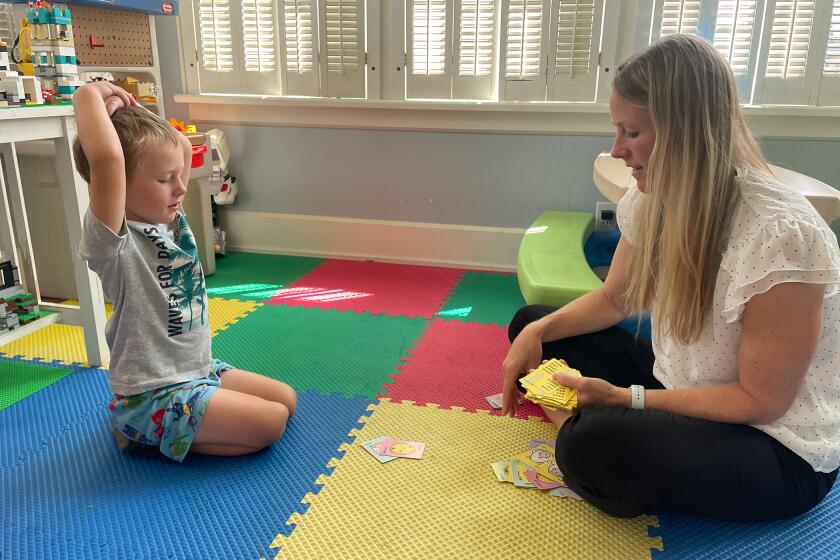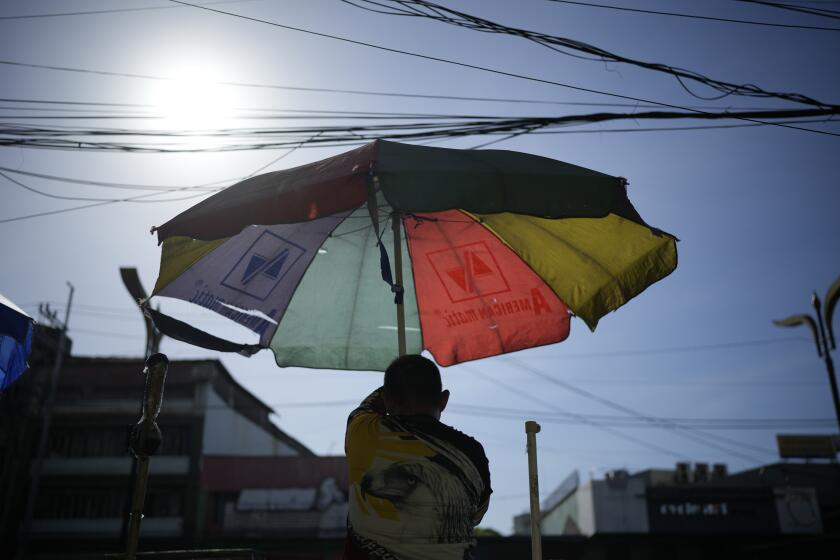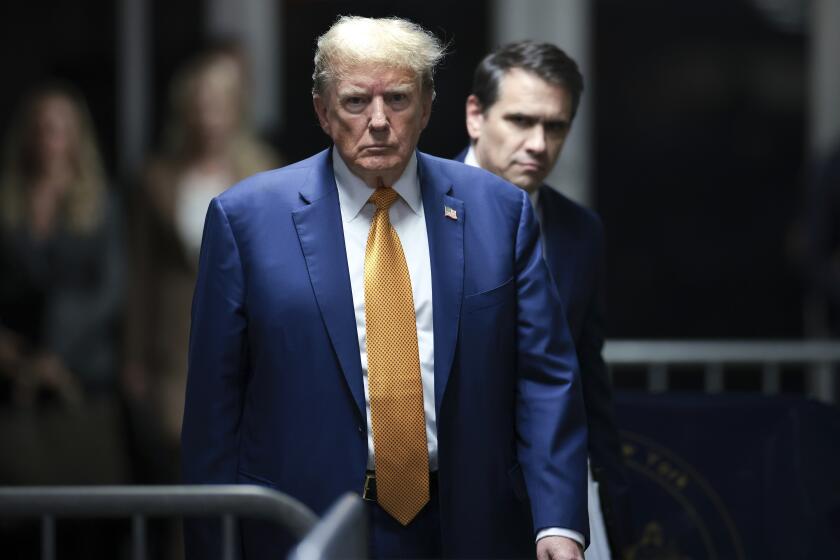30 Years After J.F.K.’s Death, Conspiracy Talk Lives On : Assassination: Warren Commission’s failure to address key questions left door open for speculation.
Intrigued by Oliver Stone’s controversial movie “JFK,” Randolph H. Robertson went looking recently for physical evidence to support Stone’s view that the assassination of President John F. Kennedy was the result of a conspiracy. He believes he found it.
A radiologist from Nashville, Robertson studied post-mortem X-rays of Kennedy’s head and convinced himself that he found a second bullet wound in Kennedy’s skull that had gone unnoticed before.
“The evidence has been sitting there for 30 years and nobody saw it. It is evidence he was killed as part of a conspiracy,” Robertson said.
To most students of the assassination, Robertson’s finding is highly implausible. But to Robertson, it is persuasive evidence that shots came from more than one direction, meaning that Lee Harvey Oswald did not act alone.
Thus another conspiracy theory was born--one of hundreds of unproven, speculative scenarios of international intrigue spun by historians, self-appointed investigators and conspiracy buffs since the fatal shots were fired in Dallas’ Dealey Plaza on Nov. 22, 1963.
Paradoxically, the conspiracy theories stem in large measure from the shortcomings of the Warren Commission itself--the investigative panel that was supposed to put the matter to rest and that declared unequivocally in 1964 that it had found “no evidence” that Oswald was part of a conspiracy.
In the 30 years since the assassination, it has become clear that the Warren Commission’s work was inadequate. While that does not necessarily mean the assassination was part of an international plot, so many crucial questions were left unanswered that conspiracy theorists rushed in to fill the void.
To be sure, many of the theorists--perhaps even most--have themselves been criticized for twisting the facts to prove their theories.
Nevertheless, in recent years, disclosure upon disclosure has revealed that the Warren Commission’s probe was less than perfect--that the members were unenthusiastic about their task, that they failed to obtain crucial evidence from the CIA and FBI, that commissioners were too deferential to the privacy concerns of the Kennedy family and that even some commission staffers were dissatisfied with their final report.
In fact, the commission’s statement that it had found “no evidence” of a conspiracy was clearly false. While the commission demonstrated persuasively that Oswald pulled the trigger of the gun that killed Kennedy, it also unearthed many inconclusive shreds of evidence that tended to suggest a wider plot.
“The Warren Commission was handpicked by President Lyndon B. Johnson to avoid any real investigation,” said James H. Lesar, a lawyer devoted to obtaining disclosure of all relevant government documents. “The reason that there are so many wild theories of what happened is because the government did not do its job of properly investigating the Kennedy assassination. We are only now, 30 years later, establishing certain fundamental facts.”
Surely the nation would have been spared the agony of this endless controversy had the Warren Commission determined Oswald’s motive for shooting the President. But even now, there is no conclusive explanation. The simplest one--that he was a violent, unstable man who craved intrigue and a place in history--leaves many Americans dissatisfied.
“We had a political crime that cries out for a political explanation,” said Burt W. Griffin, an Ohio judge and a former commission staff attorney. “The commission wasn’t able to do that. Because the commission wasn’t able to establish a motive, it left everyone else to find a motive.”
Over the years, as bits of secret evidence have found their way into the public domain, many different motives have been ascribed to Oswald, both plausible and fantastic. In truth, Oswald--a former Marine who turned to communism and defected for a time to the Soviet Union--seems to have flirted with about every group that may have had a motive to kill Kennedy.
According to various accounts, Oswald was working for the KGB, the Mafia, the CIA, Cuban leader Fidel Castro or Castro’s opponents. One researcher has developed a list of 28 people who have been named at one time or another as Oswald’s co-conspirators.
But the Warren Commission and its staff cannot be blamed for the most fundamental flaws in the findings. After all, they were hampered by the unwillingness of the CIA and the FBI to reveal to investigators certain key pieces of information.
Even now, those two agencies are being criticized for their slow response to a new law requiring disclosure of relevant government documents related to the assassination. More than a year after the law was passed, the CIA, citing national security and privacy concerns, continues to withhold at least 10,000 crucial pages of evidence and the FBI has yet to turn over even one of the 499,000 pages it has on the crime.
Not until years after the Warren Commission issued its report did the public learn that Kennedy was shot at a time when the CIA was plotting to assassinate Castro.
James H. Johnston, who studied the case in 1976 as counsel to the Senate Select Committee on Intelligence, says evidence shows that the CIA intentionally played down any indications of a connection between the Kennedy assassination and the plot to kill Castro, perhaps because the CIA feared it would learn that its own actions had precipitated the tragedy.
“In 1964, the public thought it would be told the truth about the assassination,” Johnston said. “It was not. . . . The CIA, at least, had ample reason to suspect Cuban involvement.”
Like so many other researchers and historians, Gerald Posner, author of a new book titled “Case Closed,” which supports the findings of the Warren Commission, believes that the mystery will be solved once all the evidence is made public. But newly available information from CIA files has only fueled fresh disagreement about Oswald’s motives.
In the CIA documents, Johnston thinks he has found more evidence of a Castro-inspired plot to assassinate Kennedy: a photograph taken in Mexico City of a Cuban-born American, Gilberto Policarpo Lopez, who is believed to have been in Dallas on Nov. 22 and to have fled to Cuba five days later. To Johnston, the evidence supports the theory that Castro had several designated hit men in the United States.
Likewise, John M. Newman, an Army major who teaches history at the University of Maryland and has reviewed all the CIA files, claims to have found evidence that the CIA was paying far closer attention to Oswald’s activities before the assassination than was acknowledged at the time. He contends his findings contribute to the view that the CIA had something to hide.
And the PBS show “Frontline,” which conducted an extensive probe in preparing a three-hour, 30th-anniversary program, found an old photo showing Oswald in the company of David Ferrie, a man who figures in many conspiracy theories because of his ties to the anti-Castro movement and to Carlos Marcello, the New Orleans Mafia leader.
Ever since 1966, when Mark Lane wrote “Rush to Judgment,” the first commercially successful book critical of the Warren Commission, people of all political bents have capitalized on the weaknesses of the Warren Commission probe to launch their own theories.
In the 30 years since that wrenching national tragedy, countless books have been published and numerous lives devoted to studying the evidence.
But most of these efforts--like Stone’s “JFK,” which was based partly on the largely discredited investigation of the late New Orleans Dist. Atty. Jim Garrison--have been vulnerable to criticism that they twisted the facts to prove a conspiracy.
Robertson’s findings of a second bullet hole in Kennedy’s skull, which he hopes to publish as a book, are typical of the way in which conspiracy theorists thrive on the flaws of the Warren Commission report.
At the request of the Kennedy family, the commission did not publish autopsy photographs of the late President. Then-Chief Justice Earl Warren, the panel’s chairman and the only commissioner who viewed the photos, concluded that they were too gruesome for the public to see.
Instead, the Warren Commission report included a sketch based on the autopsy surgeon’s recollections. Inaccuracies in that sketch have been at the heart of many challenges to the commission findings, including Robertson’s opinion that the shots that hit Kennedy came from two different directions.
David W. Belin, a former staff attorney who has been the most outspoken among defenders of the Warren Commission, says the panel’s “biggest mistake was to yield to the desires of the Kennedy family that the autopsy photos be kept out of the public domain.”
Commission records show that Warren, in deference to the people involved, frequently made decisions that may have compromised the scope of the investigation. For example, at Warren’s insistence, no witnesses were interviewed in private--a departure from a standard investigative technique that often yields facts unobtainable in the presence of an official stenographer.
“I think they were swayed by a fear of what they’d find if they pressed too hard,” Johnston said. “There were gentlemen’s rules back then, and you didn’t press things too hard.” Of course, the Warren Commission was created largely with the purpose of halting--not promoting--speculation about Oswald’s motives. By Warren’s own account, when President Johnson asked him to head the probe, the President suggested darkly that without such an investigation, suspicion of Soviet or Cuban involvement in the assassination might lead to nuclear war.
Johnson also ordered Warren to finish the probe as quickly as possible, to avoid any entanglement with the upcoming 1964 presidential election.
Other than Warren, none of the commission members showed much commitment to the task of investigating the assassination. According to Posner’s account, Sen. Richard Russell heard only 6% of the testimony, and only three of the seven commissioners heard more than half of it.
Commission members had reason to believe that the federal government was not cooperating fully with the probe--particularly after they learned that the FBI had concealed the fact that the name of one of its agents, James Hosty, was found in Oswald’s address book.
Many critics have suggested--apparently wrongly--that the commission never questioned an initial FBI report stating that Oswald acted alone. According to a thorough review of the commission’s work by U.S. News & World Report reporters Ted Gest and Joe Shapiro, the panel began its investigation with the notion that there was more than one gunman in Dealey Plaza--a theory that was not abandoned until investigators realized that one bullet went through Kennedy’s body and struck then-Texas Gov. John B. Connolly seated beside him.
In later years, former commission lawyers acknowledged publicly that they were disappointed with the final report, which critics say is written more like a brief for the prosecution than an investigative report.
“The Warren Commission report was simpler than it should have been,” said G. Robert Blakey, a Notre Dame Law School professor who served as chief counsel to the House Select Committee on Assassinations in the late 1970s.
In Blakey’s view, because the debate over the Kennedy assassination has not been settled in 30 years, no amount of new evidence, or even new witnesses, will ever finally satisfy every existing doubt.
“If somebody jumped up tomorrow and confessed, I don’t think I’d believe him,” he said. “I’d ask: ‘Where have you been for 30 years? Are you writing a book?’ ”
More to Read
Start your day right
Sign up for Essential California for news, features and recommendations from the L.A. Times and beyond in your inbox six days a week.
You may occasionally receive promotional content from the Los Angeles Times.






